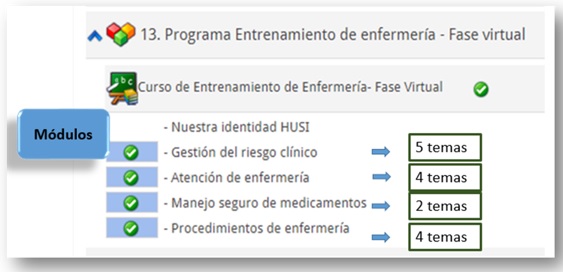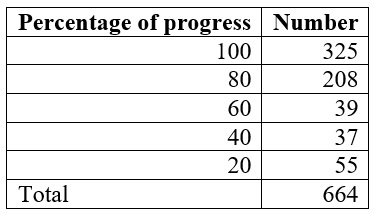Introduction
In Colombia, the first case of COVID-19 was confirmed on March 6, 2020, for which reason the Ministry of Health and Social Protection decreed on March 16 the prevention measures, initially through the Guidelines for managing home isolation, against the introduction of SARS-CoV-2/COVID-19 to Colombia (1).
The SARS-CoV-2/COVID-19 pandemic has led to increased demand for health care, including nursing care (2). This has highlighted the lack of healthcare personnel trained in the care of critically ill and highly complex patients.
In the search for articles, some specific experiences in nursing education were identified. At the Hospital Universitario San Ignacio (HUSI), the Nursing Service defined to train, qualify and retrain the personnel in specific topics, through technological platforms such as Microsoft Teams® and other office automation tools.
As mentioned in the article "Actualidades de la educación médica cubana frente a la COVID-19," "the continuity of the teaching-educational process represents a challenge in times of COVID-19" (3), considering the difficulties to conduct the traditional method based on lectures, workshops and face-to-face meetings.
Methodology
For constructing of this article, the literature related to the topic was reviewed in the databases of the Pontificia Universidad Javeriana: Academic Search Complete and SciELO. Articles in English and Spanish were considered.
Based on the experience of other health institutions in Europe and on the application of the Pan American Health Organization survey, it is vital to have organized additional personnel who can be mobilized to the services where they are required, both due to an increase in the number of patients and to the incapacity of healthcare personnel (isolation due to contagion or preventive isolation). Therefore, a diagnosis was made of the nursing staff of the specialized units with respect to their experience in other healthcare areas, and based on this information, retraining was implemented during March and April.
Previously, in the evaluation of the nursing training program, it was considered necessary to have a practical, concrete and summarized method of the transversal nursing guides and protocols in the institution; therefore, a virtual course for nurses had been developed in 2019 as support material for the training stage of the nursing staff at HUSI. At the beginning of 2020, it was in the final testing phase for its launch. This course consists of five modules, each with specific topics and comprehension assessment (Figure 1).
Fast training was proposed for the personnel that had to be hired and retraining for the personnel in the aforementioned areas, implementing the virtual resource in this learning process, which contributed in three aspects: 1) to disseminate and strengthen the fundamental aspects of patient care according to the HUSI model of care, 2) to maintain protective measures for the personnel regarding social distancing and 3) to distribute, according to the possibilities, the personnel in schedules that would allow them to comply with the two phases of training: virtual and face-to-face (Figure 2).
Results
For the nursing personnel hired at this time - 159 auxiliary nurses, 86 nursing professionals and 45 apprentices of the Servicio Nacional de Aprendizaje (SENA)—a rapid training strategy was designed to allow, in the shortest possible time, the knowledge of the institutional guidelines through phases of accompaniment and learning (see Figure 2). The strategy implemented with the personnel hired for the new headquarters enabled by the pandemic is described below:
Welcome meeting (virtual) with the Nursing Management: an explanation of basic rules of behavior, the presentation of the HUSI Nursing model and methodology of the training process.
Observation phase (face-to-face): the dynamics of the shift is presented, the functions of the position, recognition of the electronic medical record, and the Almera platform. The tutor is assigned.
Welcome meeting (virtual) with the Nursing Management: an explanation of basic rules of behavior, the presentation of the HUSI Nursing model and methodology of the training process.
Observation phase (face-to-face): the dynamics of the shift is presented, the functions of the position, recognition of the electronic medical record, and the Almera platform. The tutor is assigned.
Practice phase (face-to-face): accompanied by the tutor, the person participates in the shift. Performs care activities and records in the clinical history. The following day, patients were assigned according to the position and performed the care activities and the respective records in the clinical history, under the supervision and monitoring of the tutor.
A Phase of recognition of the headquarters and reinforcement of HUSI processes (face-to-face): during the first day there was a tour of the assigned areas. This was accompanied by a workshop on the correct use of personal protective equipment and some self-care recommendations; in addition, the institutional guidelines for the care of patients with COVID-19 and related documents were read. On the second day, theoretical-practical activities of patient care and a workshop on clinical risk management were developed, as well as reading the guidelines, according to the educational needs of the position.
For the on-site training, personnel were organized in groups, distributed in the morning and afternoon shifts, and simultaneously with the work at home modality, the virtual training course and reading of the guides were conducted.
The coordination was made with the leaders of the outpatient care and administrative areas to retrain the nursing staff of these services so that they would be prepared as support personnel in the care of SARS-CoV-2/COVID-19-positive patients in the hospitalization services. An initial diagnosis and training process were conducted.
During the training and retraining process, the virtual training phase was performed for nursing personnel, through five modules, each one with specific topics with video presentations and comprehension evaluations (Figure 1). At the end of 2020, 664 people participated, of which 66% were nursing assistants and 34% were nursing professionals (Table 1).
In the training process, the transversal nursing guidelines and other clinical practice guidelines that contribute to the integral care of the patient were also read:
Clinical practice guideline for thromboprophylaxis in acutely ill patients.
Nursing care guide for in-hospital and home administration of oxygen by nasal cannula.
Nursing protocol for the receipt and delivery of shifts.
Nursing guide for the safe transfusion of blood products.
Nursing guide for patient mobility restriction.
Basic nursing care manual.
Peripheral venipuncture protocol.
Delivery and completion of the safe practice booklet during hospitalization and nursing portfolio.
Instructions for the proper filling out of the patient identification board.
Protocol for cleaning and general disinfection of medical equipment.
Protocol for handling loss or leakage of patients.
General recommendations for administrating inhaled medications.
Nursing guide for administrating total and peripheral parenteral nutrition.
Nursing guide for enteral nutrition administration.
Protocol for preventing catheter-associated urinary tract infection.
Prevention and control of resistant microorganisms.
Prevention of bloodstream infection associated with central venous catheter-associated STI-CA.
Prevention of hospital-acquired pneumonia unassociated with mechanical ventilation.
Protocol for the rapid response team.
In addition to the above, the Emergency Unit led a pilot training program using the OneNote® tool (version available for Windows 10), which was used to train all the unit's nursing professionals (in this case 68) every six months in the triage protocol. The process had two phases:
Phase I-revision: was conducted during June and July. The use of digital notes facilitated the learning process and allowed the protocol to be consulted since it was available in a flat Excel® 2016 file.
Phase II-evaluation: It was developed during August, through an online questionnaire, which allowed us to obtain the results of each person in real-time.
The perception of the groups, in general, was positive regarding the understanding of the videos, as well as the usefulness and access to the tools; however, no specific measurement was made.
Conclusions
In one of the articles reviewed, "COVID-19 and education in medical students" (4), the health sector has the task of strengthening it through the use of information and communication technologies (5). However, access to these technologies is still limited in some centers (6).
The SARS-CoV-2/COVID-19 pandemic has generated great changes in all areas, including health education. At this time, the alternative for training, education, and retraining in nursing is the virtual modality, which has become an opportunity to develop other skills and competencies.
Monitoring and follow-up are required in all educational processes to achieve greater participation; likewise, it is necessary to establish from the beginning of the educational strategy the data to be measured, both for decision making and for possible research studies.











 texto em
texto em 






